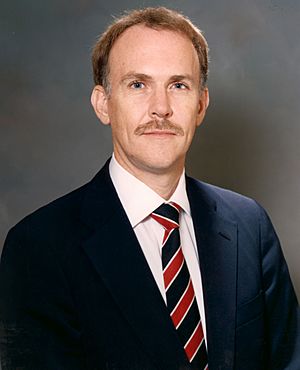William Robert Graham facts for kids
Quick facts for kids
William Graham
|
|
|---|---|
 |
|
| 4th Director of the Office of Science and Technology Policy | |
| In office October 2, 1986 – June 1989 |
|
| President | Ronald Reagan George H. W. Bush |
| Preceded by | Richard Johnson (Acting) |
| Succeeded by | Thomas P. Rona (Acting) |
| Administrator of the National Aeronautics and Space Administration | |
|
Acting
|
|
| In office December 4, 1985 – May 11, 1986 |
|
| President | Ronald Reagan |
| Preceded by | James M. Beggs |
| Succeeded by | James C. Fletcher |
| Personal details | |
| Born | June 15, 1937 San Antonio, Texas, U.S. |
| Education | California Institute of Technology (BS) Stanford University (MS, PhD) |
| Scientific career | |
| Fields | Physics |
| Institutions | Air Force Weapons Laboratory Rand Corporation NASA |
| Thesis | Electro-optical generation of electromagnetic radiation (1963) |
William Robert Graham (born June 15, 1937) is an American physicist. A physicist is a scientist who studies how the universe works, from tiny particles to giant galaxies. Graham held many important jobs in the United States government. He was a science advisor to President Ronald Reagan and worked at NASA. He also led committees that advised the government on important topics like arms control and national security.
Contents
Early Life and Education
William Graham was born in San Antonio, Texas, in 1937. He loved science from a young age. He went to the California Institute of Technology (Caltech) and earned a degree in physics in 1959.
He continued his studies at Stanford University. There, he earned two more advanced degrees. He got a master's degree in engineering science in 1961. Then, he completed his Ph.D. in electrical engineering in 1963.
Starting His Career
After finishing his education, Graham joined the Air Force Weapons Laboratory. He worked there for three years. His job was to lead research on how to protect important defense systems.
Later, he worked at the Rand Corporation for six years. This is a research organization that helps make government decisions. In 1971, he also helped start his own research company called R&D Associates.
Working with the President
William Graham became an advisor to Ronald Reagan in 1980. Reagan was running for president at the time. After Reagan won, Graham joined his team to help with the changeover.
From 1982 to 1985, Graham led a special committee. This group advised the president on "arms control." Arms control means making agreements between countries to limit or reduce weapons. He helped write a report about how well countries followed these agreements.
Leading NASA
In 1985, President Reagan chose Graham for a big job at NASA. NASA is the U.S. space agency. Graham became the Deputy Administrator of NASA. This meant he was the second-in-command.
From December 1985 to May 1986, he served as the acting Administrator of NASA. This was a very challenging time. During his time as acting administrator, the Space Shuttle Challenger was launched. Sadly, the Shuttle broke apart shortly after launch. This was a terrible accident.
Graham left NASA in October 1986. He then moved to another important role in the government.
Science Advisor to the President
After leaving NASA, William Graham became the director of the White House Office of Science and Technology Policy (OSTP). He also became the science advisor to President Reagan. He held these jobs until June 1989.
In these roles, he helped the president understand important science and technology issues. He advised on how science could help the country. After leaving government, he worked for companies focused on high-tech and national security.
Later Work and Important Advice
William Graham continued to advise the government for many years. He served on various boards and committees. These groups helped the United States Secretary of Defense and other leaders. They looked at topics like national security and defense science.
He also served on important commissions for the United States Congress. These commissions studied big threats to the country. One commission he led was about the threat of an Electromagnetic Pulse (EMP) attack.
What is an EMP Attack?
An EMP attack is when a powerful burst of electromagnetic energy happens. This energy can damage or destroy electronic devices. It can be caused by a nuclear explosion high in the atmosphere. If an EMP attack happened, it could shut down power grids, communications, and other vital systems.
Why William Graham Warned About EMP
William Graham was very concerned about the danger of an EMP attack. He warned that it could have serious effects on the country. He explained that if our modern systems were to fail, it would be very difficult for people to get food and other basic needs.
He also pointed out that many people did not know enough about EMP. He stressed the importance of protecting the country's critical systems from such a threat. His work helped raise awareness about this important national security issue.

